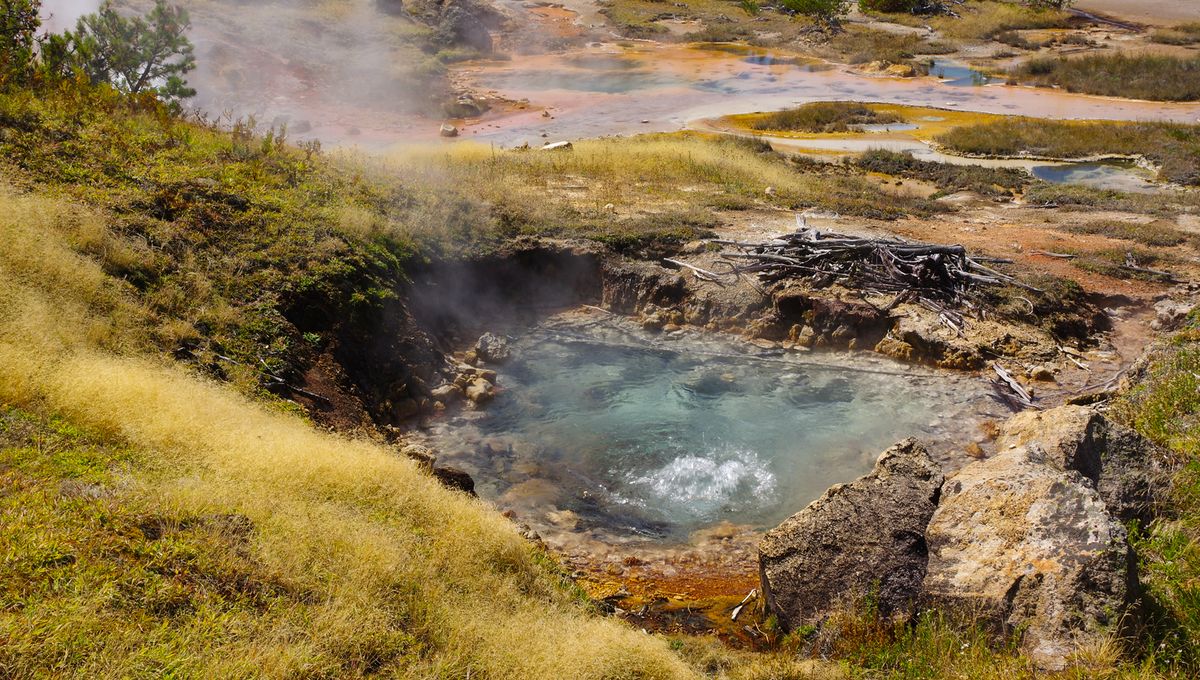
Two groups of microbes have been found living in hot water in Yellowstone National Park. The existence of the groups was known previously, because their DNA had been detected and it was clearly unlike anything we knew, but this is the first time the organisms themselves have been seen and described.
Cows are said to produce so much methane they are an important contributor to rising global temperatures, but in a sense they are maligned, as is anyone whose digestive system lets rip. The ultimate culprits are single-celled Euryachaeota organisms, for whom mammals are just the carriers. Until recently, Euryachaeota were considered to be the only life forms that produce methane as part of their natural life cycle, but a decade ago genes for the production of the enzyme methyl-coenzyme M reductase (MCR) were detected in hot springs. This is the enzyme all known methane producers use, but in this case, clearly came from something quite different.
“All we knew about these organisms was their DNA,” said Dr Roland Hatzenpichler of Montana State University in a statement. “No one had ever seen a cell of these supposed methanogens; no one knew if they actually used their methanogenesis genes or if they were growing by some other means.”
The location where the DNA was found, and the other genes detected, indicated these missing organisms thrived in very hot environments, making them unlikely to affect the global methane balance much. Nevertheless, something so different from the rest of the tree of life was bound to be interesting.
Hatzenpichler and colleagues took samples from hot springs in Yellowstone National Park (when it wasn’t exploding) that ranged in temperature from 61-72°C (141-161°F). Extremophiles (organisms that like very hot, acidic, or salty conditions) are usually very hard to grow in the lab, but doctoral student Anthony Kohtz and Dr Viola Krukenberg succeeded in this case.
They found the two new groups of organisms, which they have named Methanomethylicia and Methanodesulfokora, do indeed produce methane. This would have made them the first methanogens known outside the Euryachaeota, were it not that a Chinese-Dutch team were growing a different Methanomethylicia at the same time. Rather than race, the two teams submitted together, leading to three papers in the same journal.
Surprisingly, Methanomethylicia does not seem to be confined to volcanic environments; it’s been under our noses all this time, for example in wastewater treatment plants. The team based at China’s Biogas Institute and Wageningen University found their sample in the Shengli oil field, although when cultured its abundance peaked at 45–65°C (113-149°F), showing it does like the heat. More significantly, Methanomethylicia has been there in the stomachs of ruminants and wetlands along with the Euryachaeota we’ve been focused on.
That doesn’t mean Methanomethylicia is responsible for some of the methane from those environments. It’s possible it only releases the gas in hot environments, and grows through other paths elsewhere.
“My best bet is that they sometimes grow by making methane, and sometimes they do something else entirely, but we don’t know when they grow, or how, or why.” Hatzenpichler said. “We now need to find out when they contribute to methane cycling and when not.”
Ideally, this might lead to ways to get Methanomethylicia to switch modes, reducing emissions of the potent greenhouse gas.
The two new discoveries have a novel approach to methane production, making it out of methanol and similar molecules, rather than CO2 or acetate like the Euryarchaeota we knew.
The origins of Methanomethylicia and Methanodesulfokora are unknown, but they are suspected of being very ancient, and possibly offering insight to the first life forms on Earth. If so, they could also give us a better idea of what seek in looking for life on other planets.
Meanwhile, Methanomethylicia raise other questions, like why do they have tubes that connect two or three cells to each other, and is this some preparatory step to the formation of multicellular life?
“We have no idea why they are forming them. Structures like these have rarely been seen in microbes. Maybe they exchange DNA; maybe they exchange chemicals. We don’t know yet,” said Hatzenpichler.
Methanomethylicia and Methanodesulfokora come from the Thermoproteota and Korarchaeia phyla, respectively.
The MSU team’s paper on culturing Methanomethylicia is published in Nature. The Methanodesulfokora paper is published in the same edition and the Biogas Institute/ Wageningen University team’s work on Methanomethylicia is also published in this edition.
Source Link: Methane-Producing Microbes Unlike Any Seen Before Found In Yellowstone’s Hot Springs